#cos gestalt
Explore tagged Tumblr posts
Text






intermission ✦ izek + victor
--- ko-fi // creator commentary
1K notes
·
View notes
Text
✷



@nouveaumoon @cosgestalt
Um hello!! ;;👉🏻👈🏻
I REALLY like the way you draw the Abbot!! He's so amazing in your execution! my dm informed me that you are feeling ill now, so I decided to support you and send some sketches with the Sun! I hope this will cheer you up! ☀️🕊️✨
#curse of strahd#curse of strahd spoilers#the abbot#cos gestalt#illustration#procreate#artists on tumblr#dnd#dnd art
6K notes
·
View notes
Video
youtube
Profundizando en la Terapia Gestalt Aplicada con Ana Giorgana e Ivonne M...
#youtube#Curso sobre la intervención en el Self en la Terapia Gestalt: https://institutocedes.com/courses/el... https://institutocedes.com/courses CO
0 notes
Text
niche fantasy whump
in which the main character is a fusion/conglomerate of multiple souls. (See Merger of Souls page for details)
possible scenarios:
-character goes crazy from having such discordant thoughts and opposing worldviews trying to co-exist
-character contains the fusion of a suicidal and a non-suicidal soul. the suicidal soul is dominant.
-less drastically, one soul is prone to self harm, and the others have to endure it
-souls fused into a body that isn't their own, that not all of them like
-whumpee forced to literally share a consciousness with whumper, and vice versa
-whumpee and caretaker existing as a fused consciousness, but neither of them really existing anymore within this new person, or ever able to see each other again
-traumatized whumpee's memories being shared against their will, other souls receiving these memories against their will
-trying to exist as two separate people again if the souls are suddenly split
-loved ones trying to adjust to the change/loss of the constituent souls, or mourning the loss of the gestalt if the souls are split
#whump#whump scenario#whump prompt#whump community#whump writing#no points for tagging this with locked tomb or homestuck btw!!! it wasnt subtle#my prompts
80 notes
·
View notes
Text
Is there a term for like, mutual dependency that is not, like co-dependent, implying that this is super unhealthy or manipulative or whatever? cause I really enjoy that kind of relationship in fiction, where they fit together in such a way as to make a gestalt that is greater than the sum of the parts and fall apart into pathetic wrecks alone; where they are a wild combination of hypercompetent and failboat that only works because they have eachother to lean on.
62 notes
·
View notes
Text
The themes of NieR Reincarnation
A post about the recurring elements of Drakenier and the use of branching timelines as a storytelling device. I'll be discussing spoilers for basically every DoD/NieR game.
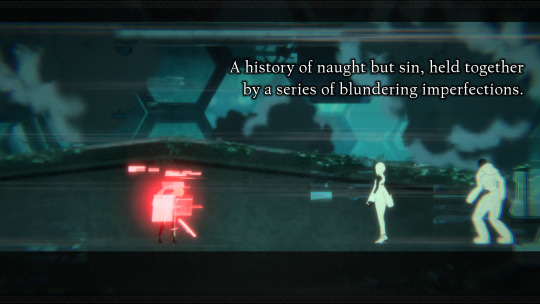
Records
A somewhat understated recurring motif of the Drakengard/NieR series is the idea of stories or memories of humanity being stored in some massive archive.
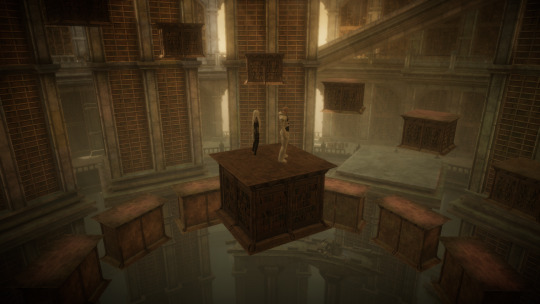
It's an idea that first entered the series in NieR Gestalt/Replicant. Early drafts of the game focused on the idea of a world built out of stories and fairytale characters, and while most of this was cut, some remained in the Forest of Myth area.
Following NieR's obsessive love of hopping between different game genres, the story here is delivered through prose/text adventure segments. There is a sense that this area of the game exists as prose, with the characters slightly aware of narration - narration which absorbs the characters until you find a way to escape. Eventually you find out - it's rather cryptic in the actual game, but spelled out explicitly in Grimoire NieR - that it's a huge computer system storing records of the deceased humanity.
In your second visit to the area, the story focuses more on distant history, that all these stories are fragments of memory of the lost pre-apocalpytic world. You encounter a Gestalt (human soul extracted from body) that is eating the memories stored in the tree, and kill it, and for Nier and co., this is enough - but for the player, you really don't know half of what is going on.
In the story The Lost World, which was adapted for the additional Ending E added in the Replicant remake, Kainé returns to the Forest of Myth and finds the computer system expanding. She fights clones of herself before eventually speaking to a mysterious administrator and descending into a virtual world that seems like a corrupted version of her memories. But she's able to connect to her memories of NieR, Emil and Grimoire Weiss, and through that connection cause a kind of timeline collapse effect that allows her to resurrect Nier. Terms from DoD3 such as 'singularity' come back again.
youtube
In NieR Automata, the idea of the legacy of humanity becomes increasingly central. While the androids believe they are reclaiming Earth for humanity, the Machine Lifeforms' motivation is in large part driven by their efforts to pore over the records of humanity and learn how to evolve their condition, even by blind imitation. Many of the different Machine Lifeforms you encounter are shaped by their interpretations of human society. The motif of human buildings recreated in white blocks recurs at certain points.
In the final sequence of the game, you climb a tower, and inside it visit simulacra of locations from the Replicant/Gestalt. You learn that the machines have infiltrated the androids' network and downloaded basically all the information the androids have, including all their records of humanity. When the machines' 'Ark' is launched into space, it carries their memories and consciousness in data form.
The YoRHa: Dark Apocalypse raid series in FFXIV continues this idea of obsessive, blind reconstruction. The machines you fight here are now all the more explicitly connected to the apocalyptic shit in DoD; they have also been frantically creating duplicates of YoRHa android 2P, the Bunker and so on in corrupted form. Although the story here has mostly other interests, it's another recurrence of the idea of trying to recreate things that were lost.
Along with this idea of the archive comes the idea of preservation of that archive. Whether by accident or deliberate attack, the survival of the archive is not guaranteed.
This is all absolutely central to what Reincarnation is about.
Branches
The Drakenier series has played around with branching narratives pretty much from the start. It's somewhat infamous for it in fact - did you know that NieR is actually a spinoff of ending E of Drakengard, the one where you appear over Tokyo and have to do a rhythm game? Yeah, so...
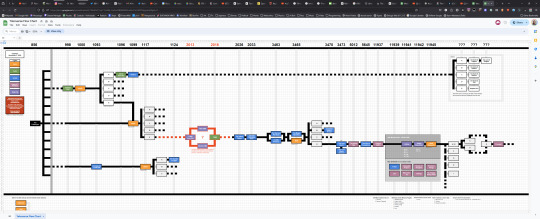
Most games are fairly cagey (ha ha) about the mechanics of these branches. Indeed, although we speak of branches, the structure of these games is not really a branching one like a visual novel. The branches and 'endings' are usually unlocked sequentially.
Drakengard/Drag-on Dragoon (DoD1) is probably the closest you get to a traditional branching structure. You can unlock routes in certain missions by fulfilling certain conditions. The exact logic of these branches is not really explained - you can go back to a point before you recruit a party member and get a different branch where they're present for example. That said, it's not like a visual novel where you can be 'on' one branch or another - you can always jump to any level from any timeline.
This oddness of the branches is also lampshaded a little more in DoD3, the game that is most explicit about the nature of the branching timeline. DoD3 is, from the player perspective, a linear game. After you complete the first 'ending', you unlock new levels that appear at earlier points in the timeline, and diverging branches appear. In the later branches, the logic of the world is starting to break down. Party members who you'd recruit later in the story are in your party much earlier, in some cases suffering from amnesia, the implication being that it's an effect of the Flower's corruption.
The game is intermittently narrated by a character called Accord, an android 'Recorder' whose job is to document all the different versions of the story for an unknown party. Accord isn't supposed to intervene in the story, though she occasionally talks to protagonist Zero, and in the final D route, she decides to break the rules and save Zero. Otherwise, she's responsible for 'sealing' branches where it seems the world cannot be saved.
This is Accord:
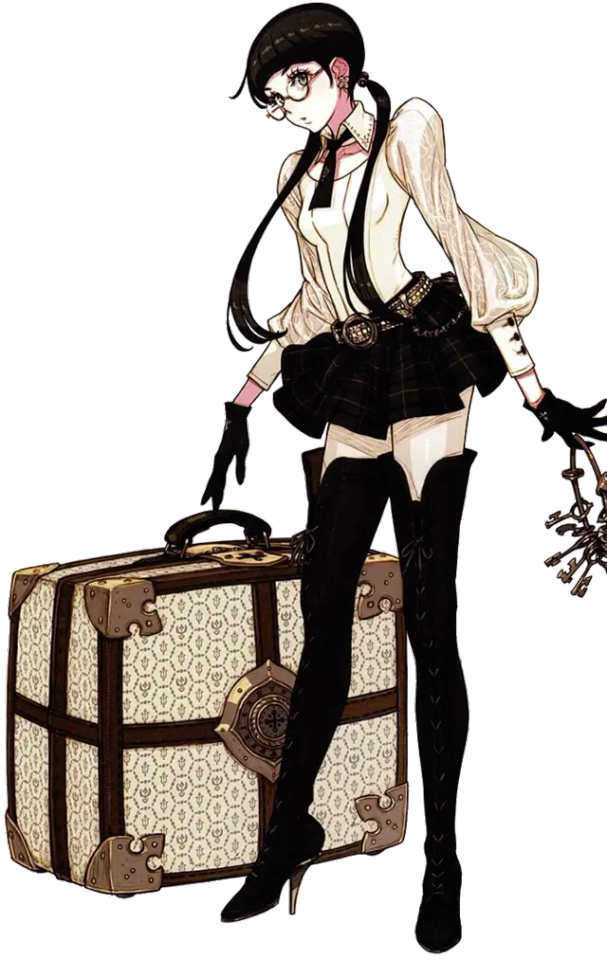
The final cutscene of DoD3, available only after you beat the ludicrously difficult rhythm game that is the 'final song', shows a bunch of other Accords appearing and talking about what a mess this all is.
Accord's other role in the game is to sell weapons. Another series tradition running back to DoD1 is the 'Weapon Stories'. In each game, you can collect weapons, which can be upgraded through a series of four stages. Each stage unlocks another part of a story. These stories tend to be quite brief - each entry is at most a short paragraph. They also, particularly in the DoD games, tend to be comically grimdark.
DoD 3 came out after NieR Replicant/Gestalt, but in every game since then, there have been cryptic mentions of Accord. In Automata she's mentioned in a note as a weapons seller; in the updated version of Replicant she is mentioned as visiting Nier's village while the party is away on her adventures, and you see a documention that mentions the 'Accord Corporation' supplying magic weapons.
OK, so, put a pin in that, we'll come back to her later.
The side material commits further to the branching idea. The original Drakengard is established to follow from the DoD3 Story Side novel, while Branch A gives rise to the Shi ni Itaru Aka manga and the DoD 1.3 novel. The YoRHa stage plays spawned alternative versions, namely YoRHa version 1.3a and Shōjo YoRha version 1.1a, with the gender of the casts flipped. YoRHa 1.3a also has Accord in it. The anime NieR Automata ver. 1.1a also presents an increasingly diverging version of the events of the game - notably, Adam turns into a multi-armed monster.
DoD2, something of the black sheep of the franchise, was originally written to follow DoD1 ending A; later it was retconned to belong to its own branch. Just 'cause.
With me so far? ...no? Yeah, that's fair. You can read about all the details I've gathered so far here, but in short, there are lots of timeline branches, and multiple versions of several stories with small or large divergences.
Reincarnation
NieR Re[in]carnation is a gacha game that's been running for the last three years, and is going to be shut down at the end of April. At the time it came out, it was acknowledge for having unusually nice graphics for a mobile game, but rather desultory, grindy, repetitive gameplay. Which remained true throughout the game's life, so I can't exactly recommend playing Reincarnation, especially at this point.
But! I would definitely say it's worth your time to dig up the story on Youtube/Accord's Library if you're into NieR stuff. I won't be going into all the ins and outs of the story and how it all fits together in this post, but I am gonna talk about how it's structured.
NieR Reincarnation places you in a vast stone city called the Cage, calling to mind the environments in Ico. At the outset, you play as a young girl travelling with a weird ghost-like creature called Mama, tasked with restoring the memories stored in objects called 'dark scarecrows' which are being subverted and corrupted by black birds which form into various monsters.
Within each chapter of NieR Reincarnation, you get a short story in four parts, presented in a kind of cutout style, which are the four segments of a weapon story. You collect the weapon and the character.
The Cage is shaped by the content of the weapon stories somehow bleeding into the simulated setting. A character's memories can be used to restore the stories to their proper course. It is possible to interfere in small ways with the worlds of the stories.
The corruption of the stories tends to involve subverting characterisation to make them crueller, more prone to random violence etc. - or points when a character could be threatened in a narratively unsatisfying way. For example, a peace-loving runaway prince could be turned into a warlike king.
Over the course of the first arc, you discover that the girl you are playing is actually a monster who has taken the form of a human girl and, regretting it, wants to give her her embodiment back. The second half of the arc has you playing the girl trying to reunite with her monster friend; at the end, you get her own backstory as a victim of brutal prejudice. After all is said and done, both characters transform into weapons, which Mama picks up and hides away.
The second arc, The Sun and the Moon, deals with a brother and sister from present-day Tokyo. Both of them have been transported into the Cage by more of the weird ghost thingies, to participate in a strange ritual that is allegedly going to restore the Cage. The rules are highly mystical - a significant sacrifice is needed.
In the most recent arc, The People and The World, the characters all emerge from their stories as the Cage becomes increasingly corrupted. We finally get the long awaited point where these characters can interact with each other, and advance the stories from a series of tragic vignettes to something more. At the same time, we get a lot more allusions to other games in the series - from the Lunar Tear room where Emil memorialised Kainé and later 9S memorialises 2B, to a brief appearance Devola and Popola.
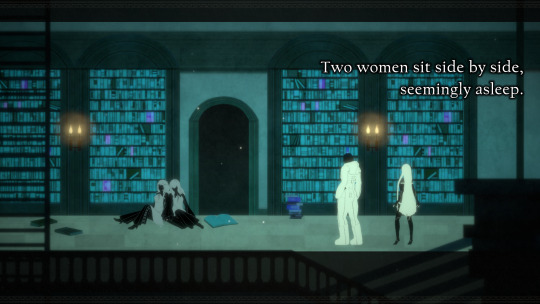
There's even a nod to Yoko Taro's other terminated gacha game, SINoALICE, which is going to be made into a movie oddly enough. There's a wry nod to the game being shut down.
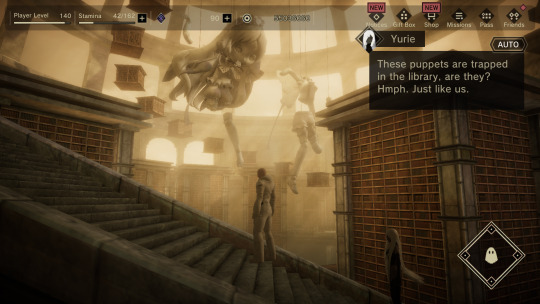
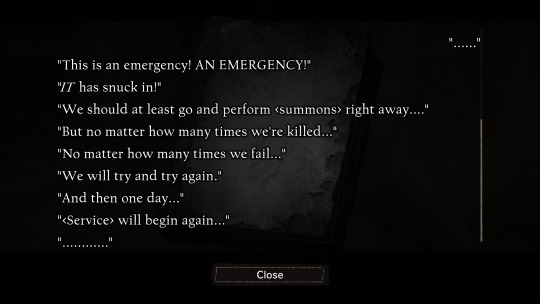
And in the most recent chapters we find out that the Cage is actually a server on the moon containing records of humanity - 10H from A Much Too Silent Sea is one of the main characters. 'Mama' is actually the Pod tasked with overseeing the archive, and wiping 10H's memories whenever she learns too much - though it seems at some point 10H learned the truth and affirmed that she'd protect the archive anyway and they stopped wiping her memory.
Over the course of the chapter, 10H helps the gang make their escape from the moon through the androids network, to Earth. But when they get to Earth, they find themselves in a strange white city more resembling the Cage.
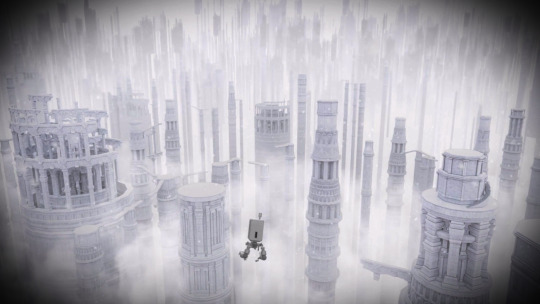
We'll finally get some answers, maybe, later this month. Anyway...
So, these records come from multiple diverging timelines, and they take the form of weapon stories. You have a unity of the ideas of character - weapon - memory - world. A record is simultaneously a tragic series of events, a person who can manifest inside the Cage itself, a simulated world which other people can visit, and a weapon.
In addition to the main storyline chapters and 'character stories', each character is associated with two additional 'EX' storylines, termed Dark Memories and Recollections of Dusk. Each one is a much more substantial narrative than most in the game.
Some of these EX stories clearly take place in different timelines to the first ones we encounter. Akeha's story, for example, takes place after her death in the original version. For the brother and sister from the Sun and the Moon arc, originally from present-day Tokyo, their Dark Memories take place in the backstory to NieR Gestalt/Replicant - the period where humanity is dying out to White Chlorination Syndrome and fighting monsters called the Legion. In this one, before the siblings could be torn apart by family drama and resentment, the apocalypse happens. Both of them end up coming into their own as heroic fighters. In the finale arc, the characters learn a bit about these alter egos, and it's made very explicit that this is a different timeline.
The monster Levania's Dark Memory is especially weird. It's the story of a salaryman who plays a monster called Levania in an MMORPG. His MMO character inspires him to live more bravely in the real world, and his life seems to be improving, but he is murdered by a jealous coworker. He wishes for reincarnation as he dies - classic isekai stuff. But the connection to the Levania you encounter in the main story is far from clear. Are all versions of Levania derived essentially from this man's tulpa?
The nature of the 'enemies' attacking the Cage is still not yet clear. They take the form of black birds. The birds are given a small amount of dialogue and characterisation, and they seem to not be malicious, just confused. The girl from the first arc in particular tends to interact with them sympathetically. However, they seem to be connected with the mysterious 'God' who was trying to destroy the world in DoD1, and the Angels and Flower of DoD3.
The birds are able to gathe together to manifest much larger monsters, the largest being giant elk and fish called Cursed Gods. During the finale arc, one of these becomes something that resembles the Mother Angel from DoD1 - and yes, there is a rhythm game - though mercifully a pretty easy one.
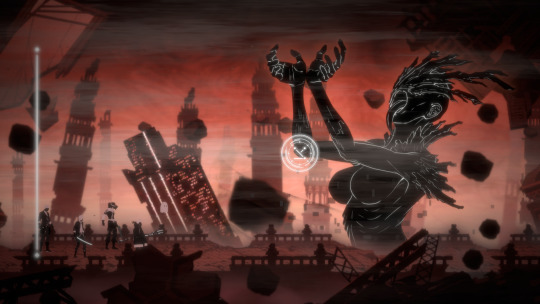
In the same arc, the character Yurie, an AI city overlord with grandiose ambitions and a loathing of imperfection attempts to download the entire history of humanity from the Cage and become a more perfect being. She succeeds, only to find the answers disappointing...
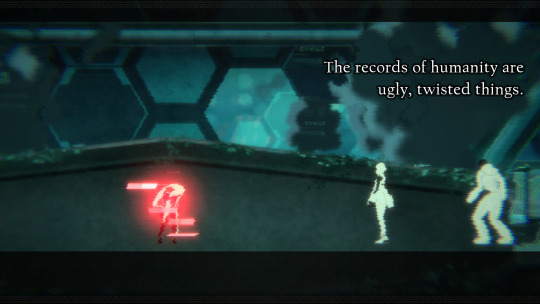

This is perhaps the closest thing we ever get to an explicit statement of what all these stories and histories add up to, but despite all this, the throughline is very strongly that these stories are essential to preserve. NieR characters exist in small groups, and it is their intense connections to these others, their treasured memories of travelling together, that motivate them to fight to preserve that thing, even if the results are destructive.
Similar themes emerge for example in Noelle's Recollection of Dusk story, which sees her travelling to preserve a place valued by her sister in crystal. And they also connect to the theme of sacrifice - the recurring ending device where the player must delete their save data in order to help someone (something echoed in Hina and Yuzuki at the altar of the sun and moon, or Levania and Fio). It's perhaps fair to say that nothing is more valued in the world of Nier than memories of a treasured person.
What about Accord? She has in fact made a brief cameo in Reincarnation already...

It seems incredibly likely that Accord originates from the Cage, and the accumulation of weapon stories is accomplished by androids like her. Definitely in the fandom there's a lot of excitement for the idea that Accord - something of a fan favourite - will show up at Reincarnation's ending.
So mystery solved, the Cage exists in the world of NieR Automata on the moon server? Not so fast - there are various discrepancies which seem to suggest that the world of the Cage exists in a separate branch than the one we see in Automata. For example, the androids are aware that the humans are dead and what remains on the moon is a huge archive of their memories; the humans seem to have survived much longer; 2B and 9S seem to have died in different circumstances. There are other oddities which fans have compiled.
And yet, despite being a divergent timeline with a much older point of divergence, some things seem to be fixed. There is still a YoRHa, still a 10H deceived about being on the moon, still a 2B and 9S.
One popular fan theory is that Reincarnation belongs to the NieR Automata anime (ver1.1a), since Adam turns into a monster there similar to the ones in Reincarnation. The black birds are reasoned to be the Machine Lifeforms, since we know they come from Earth. I'm not 100% sure of this, but maybe?
Anyway, that's basically the gist of it.
A story told through permutations
In many fictional series with a shared universe, there is an effort to maintain a consistent shared universe, so all the different events can fit into a timeline with understandable cause and effect and characters living out their lives. Even when this proves impossibly unwieldy, as in comic books or Star Wars, the attempt is made.
NieR does not really take this approach. The creators leave many details of the world, such as place names, incredibly vague - the focus is always on telling an emotional story with characters. There is, as we've seen, an almost gleeful willingness to declare another new timeline.
There is also a certain aspect of repetition, or more kindly reiteration - the same core character dynamic revisited and retold in various forms. (2B9S gets the worst of it). A character is something like a principle or ideal, and each story shines another light on that 'core'. In the earlier storylines of Reincarnation, it became quite frustrating because it seemed like e.g. the character event stories were just rehashing the same idea rather than advance the story.
However, the more accustomed I get to this style of storyline, the more I think this kinda works. It is of course quite similar to the ideas proposed towards the end of Homestuck, or to time loop stories - the idea of varying the contingent circumstances to try to better illustrate the core characterisations and dynamics.
Yoko Taro has talked about how he constructs stories from a very simple idea, typically a moment of high emotional impact at the climax, and then works backwards to figure out what sort of story could lead into that. In Reincarnation, each character gets fairly limited time to establish themselves, so they tend to be defined in terms of a pretty narrow high concept.
For example, Akeha is an assassin in a vague historical Japanese setting; her introductory story sees her decide for the first time to disobey her lord after she finds another person who has been treated as instrumentally as her. Most Akeha stories focus on her assassinations, her relationship to her retainer, and what she sacrifices to perform the duty. Only her Dark Memory lets us see an Akeha who has escaped that life - it's a simple story about preparing food, but that's given meaning by all the other Akeha stories.
Hina and Yuzuki are defined by the same traits in their flashy scifi Dark Memory stories as in the more mundane ones - Yuzuki the quiet outcast, Hina the self-sacrificing star. Fio is defined by kindness in the context of abjection, seeing the good in monsters. Levania stories are about the desire for escape and transformation. Argo is always a shitty dad who only feels alive while climbing mountains.
The staticness of these characters seems on some level to be the point - in that we are told in Hina and Yuzuki's story that the mechanism of the Cage is to sort characters into 'Light' and 'Dark' natures, and push them to inevitable conflict, even if they try to break free. In the final arc, the characters seem to finally approach some resolution as they leave their contexts behind. Given the themes of Automata in rejecting an inevitable tragic fate, similar movement may be at work. There's an ambiguity - the need to hold on to even tragic histories, vs the wish to not be confined to them. (Perhaps it's significant that it's called the Cage...)
With so many balls in the air and so many mysteries still unanswered, it's hard to figure out how Reincarnation can deliver a satisfying resolution in just one remaining chapter, but the final arc has been really cooking so who knows! But I'm also coming to appreciate it as a kind of broader lens to notice all these recurring elements and tie them together.
Stories about alternate timelines and branching narratives are very common nowadays, particularly as a tool for revisiting a nostalgic franchise. Something something effect of the fan wiki era. So I can't exactly say NieR is doing something completely unique, but I do think there is something to its fragmented, collage-like approach to putting together story elements. There's something quite honest about it - an ability to say 'these details aren't important'.
Yoko Taro always talks about himself as an entertainer rather than an artist. And probably it is true that a lot of this eemerged from an iterative design process rather than being the plan from the beginning (the first draft of NieR envisioned it as something closer to what SINoALICE ended up being, about a world of fairytale characters; NieR Automata began life as backstory for an idol project). There's definitely a strong sense that it's being improvised. And yet despite that, it does feel like it is cohering into some sort of picture, that there is an artistic throughline to all this.
Or perhaps that's just the effect of getting way too invested in something. I won't deny that NieR brings out the fan in me.
Anyway Accord had better show up next month. Guys. You've been teasing us for so long...
#nier#nier replicant#nier automata#nier reincarnation#drakengard#drakengard 3#computer games#Youtube
230 notes
·
View notes
Text
REPLIKA BIOMECHANIK
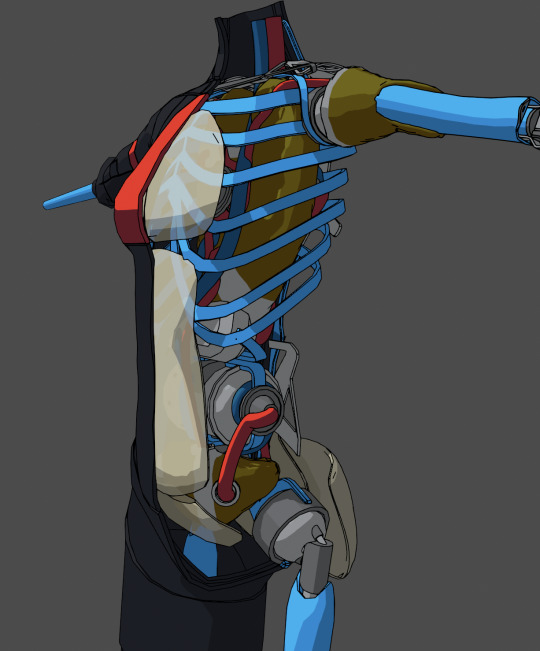
AEON Replika units incorporate both mechanical and organic parts in their construction. All replika units are based on a titanium skeleton, which is covered in a layer of protective plastic, giving it a distinctive blue look. A variety of biocomponents are also present, regulating energy production, filtration, and to mimicry of pain response. Mechanical components are used in high-intensity areas such as power production, oxidant flow, and high-strength locomotion. Artificial padding protects internal components and is used to give replika units an appearance similar to gestalts, improving co-work.
#signalis#blender#3d#OK so this started as just making the ribcage and a few bones to help with mesh setup but i got uh. carried away
347 notes
·
View notes
Text
Thank you for the tag, @pauls1967moustache! My heart is in my fiction, and I'm happy to talk about a bit. <3
How many works do you have on ao3?
15! All within the Beatles fandom (various pairings, but with a focus on J/P).
What’s your total word count?
95,825.
What are your top 5 fics by kudos?
In John's Lap (early days mclennon), play me one of yours (early days, Jim POV on J/P), Brian Manages (Sole Direction) (1968; Brian lives AU/Fix it, mclennon from Brian POV), Serenade in Paul (PWP mclennon), I was the dream weaver (1968/1969 breakup, angst; John POV)
Do you respond to comments? Why/why not?
I do. I deeply appreciate it when people take the time to let me know their thoughts, or simply that they liked my story—and replying feels like completing a handshake.
What's the fic you've written with the angstiest ending?
Probably I was the dream weaver—there is some hope in the end, but it's a small flame in a dark night. But the love is there.
What's the fic you've written with the happiest ending?
I think Brian Manages, which is only appropriate, since it's a Secret Santa gift (2023). Yes, the story is about saving Lennon/McCartney, but it's mainly about Brian, and it was important to me to give him a happy ending as well. And, of course, Eyes of the Storm: John goes to a private opening of Paul’s EYES OF THE STORM exhibition to meet with Paul, who, after many years and many ups and downs, is still his lover, and his favorite collaborator. Shameless wish fulfillment fic: John lives, everyone lives…and everyone is there.
Do you write crossovers?
Not yet, but I would love to one day! I can't think of any, though...
Have you ever received hate on a fic?
Not yet.
Do you write smut? If so, what kind?
I do write smut, and I think I tend to write smut with feelings. No specific kinks yet, except...Paul's leg fur and body hair. And his entire spritely gestalt.
Have you ever had a fic stolen?
Not that I'm aware. Brrr.
Have you ever had a fic translated?
Again, not that I'm aware.
Have you ever co-written a fic before?
Yes, twice, with @ohjohnnysblog. Thank you, OJ, for holding my hand during my very first fic, Storage Space, and for coming back for Serenade in Paul!
What's your all-time favourite ship?
I'm probably mainly a John/Paul fan, but I have a soft spot for Paul/Mal, and actually enjoy Paul/ any male Beatles-adjacent character, or Paul in a threesome...
What's a WIP that you want to finish but don't think you ever will?
I am determined—*determined!*—to finish my story about Old Man Paul releasing his mclennon dreams/memories on the world. I'm also determined to write a long Woodland Sprite Paul AU. One day.
What are your writing strengths?
I swear I'm not fishing for compliments, but I honestly can't say. I don't hate my writing, I'm just reluctant to analyze myself that way, you know. But if I had to pick one: I think I have the ability to remember, out of all the Beatles stuff I read and saw and thought about, the right detail at the right time while writing. Not as in listing facts, but as in: this would fit nicely here.
What are your writing weaknesses?
English isn't my first language, which in the context of Beatles fic means I'm not your best choice if you're looking for realistic Liverpool dialogue to leap off the page. I wish I had Paul's talent for mimicry...!
What are your thoughts on writing dialogue in other languages in a fic?
People can do what they want, but if there's entire pages in a language I can't read, and no footnotes to help me, the story isn't for me. Individual words and phrases are a different thing, of course.
What was the first fandom you wrote for?
This one! Beatles! McLennon! Paul, you were my first, and I was your billionth!
What's a fandom/ship you haven't written for yet but want to?
Breaking news, I think I might try my hand at Peaky Blinders at some point...
What's your favourite fic you've written?
Similar to you, Mo, I love all of mine equally, but I have special love in my heart for the fic that lifted me out of a spell of the writing horrors this fall: Johnny Gentle and His Group, about the Silver Beetles' 1960 Scottish Tour. And, of course, Hurricaneville: leg combing McLennon in 1961!
Tagging, if you’d like @eveepe, @revollver, @m1ssunderstanding, @unchaineddaisychain , @therealsaintscully and @scurator!
#asks#my fic#writing#my navel isn't as furry and soft as Paul's but it was fun to gaze at it nevertheless!#mclennon fanfiction#mclennon
36 notes
·
View notes
Text
some swindle and hardtop es ideas
swindle and hardtop reunion in g.h.o.s.t but when swindle sees hardtop he gets the overwhelming dread that something is different and it’s not just his missing arm
swindle and hardtop reunion but when they try to hug each other they both get shocked by the barriers and are forced into cells really, really far from one another (bonus points if they can hear each other but cannot see) ((bonus bonus points if one of the other cons has to be a middle man between the two)) (((bonus bonus bonus points if it’s soundwave lmfao)))
swindle learning that the last of his gestalt (brawl) is dead by going to the remains of the bot brawl arena ( with hardtop if it’s after season 1) and seeing his empty husk on the ceiling
swindle actually staying around as thrash’s weird devil-on-his-shoulder mentor and he co-dad2s with bumblebee or prowl
hardtop and swindle stay on earth because swindle wants his scatterblaster really bad and hardtop likes to collect earthly comics
swindle gets in contact with wheeljack or tarantulas and begs for a new arm for hardtop (bonus points if it’s some weird ass gadget that hardtop equates to one of his favorite characters so he keeps it)
hardtop and swindle steal candy from babies <3 but instead of babies it’s actually just the maltos
#transformers#maccadams#earthspark#es swindle#hardtop#tf swindle#tf hardtop#light angst#tf prowl#tf bumblebee#tf brawl#es bumblebee#es prowl#es brawl#tf wheeljack#tf tarantulas#es wheeljack#es tarantulas#tf soundwave#es soundwave
20 notes
·
View notes
Text
Ishmael must have been alone after she became a Watcher/Observator, witnessing multiple birth and death of civilizations that fell to their own trials like hers almost did if she hadn't put it in a stasis. Maybe she had a few relations here and there but nothing too friendly too close, in order to not be submerged by the feeling of loss again.
She only watch those civilizations rise and fall in hope that one of them will win again those trials to save her own dimension, her friends, family and co-workers, even if there's not many of them left. Maybe she even helped a few individuals to go through the gate, making them watchers too and join the already mass of individuals that also have that role, restricted by rules because it was the only way for them to survive against the filtering of their dimensions.
So how much of a shock it must have been to her when Lee, with his limited grasp and understanding on time-travel, dimensions, alternative universes he learned not long ago in the Hetero-Tower with the help of multiple versions of himself that failed the trials of the Tower, Lee who only wants to protect those closest to him, to save them from the threat and futures he went through, and perhaps in a certain point of view, who's a reflection of Ishmael's owndesires and therefore should have accepted her offer, said no, they are waiting for me, thinking of SKK, Lucia, Liv and Murray because they are his family.
What do you think went through the head of the Merciful One when she heard his answer, denying powers and comprehension of their places in the universe that would take a long time for humans to control ? Yet she gives him her blessings, she lets him go, she doesn't force him to stay because a part of his answer, who he is to decide the fate of humanity alone, is correct. She had started to watch Gray Raven closely the moment Liv was on Empyrea but she watches them closer after the Hyperreal user defies her expectations.
Then she assist to a third (Lucia) and fourth round (SKK) of Gray Raven trying to find a future where they are together or their loved ones lives on, the last one actually going through the door with her help but chose to go back in time instead of stopping the time of its world, traveling to other dimensions with her to find a solution elsewhere, and finally giving her company and someone that can understand her other than Gestalt, which would have been safer for Skk or Lee if he had chosen to accept her offer.
But no they are stubborn, refusing to sit and watch idly, doing nothing while other are fighting for their futures because you obtain nothing if you stay passive. So she finally takes a stand too, even if she has to pay a great price for it.
And maybe, maybe she is starting to fall slowly but hard for those two that showed her the way, reigniting feelings she had long since foregone and forgotten because they are useless to her current situation. And as a raven from another dimension and civilization, she can't let them do everything, she has to show she is a raven they can trust.
TL:DR Leeshmael, skkshmael, leeskk and leeshmaelskk are living rent free in my brain, rotting inside of it and this is my thesis/analysis on them, with a pinch of raven courting behavior on Ishmael's side since her civilization has apparently raven in its name.
#pgr#punishing gray raven#pgr ishmael#pgr lee#pgr commandant#i have been absorbed by these ships#leeshmael#leeskk#leeshmaelskk#skkishmael#coming up with ship names i know
21 notes
·
View notes
Text

happy organ donor day! are you registered? here are some gifts now available to celebrate your life while you have it! (additionally, if etsy does not work for purchasing in your region, DM me and we can work something out!)
CHARM || BUTTON || GESTALT UPDATE
#webcomic#update#curse of strahd#curse of strahd spoilers#merch#acrylic charm#button#curse of strahd gestalt#cos gestalt#strangely the preview image on the homepage isn't updating. i will try to diagnose after lunch#i will also be adding a newspost later. but i am sooooo hungry. lunch lunch lunch#edit: homepage now has the correct preview image yayyy
83 notes
·
View notes
Text
Texts in Like Minds: Sally's Books

After her first encounter with Alex, Sally returns home and consults a stack of books while listening to the recording of their discussion. Of this stack, only two titles are discernible. The first book is shown briefly and set aside, and the second is opened to a bookmarked page. This large tome is titled Principles of Criminal Psychology (Fifth Edition), by George R. Booth and Andrew Porter. Sadly, I cannot find even the tiniest scrap of the existence of this book online. It is clearly a textbook, and presumably one she would have kept from her school days given that it’s directly relevant to her career. The bookmarked page is titled “Chapter 27: Gestalt Theory”, and the opposite page features photos of Leopold and Loeb, who I have discussed elsewhere. The text itself is unfortunately not clear enough to be readable.


Returning to the first book we see, there is much more information to be found online. It is titled Gestalt Therapy: The Attitude and Practice of an Atheoretical Experientialism by Claudio Naranjo, first published in 1993.

The recording Sally plays during this moment is their exchange regarding gestalt. This concept is one that the movie highlights in this scene and again at the end during Sally’s address to her peers, but it does not clearly define or explain the idea of “gestalt” for the audience. Gestalt first arose as a philosophical principle suggesting that the experience of the parts of something cannot fully represent the whole of that thing, like the notes of the song versus the experience of the song itself. A cursory search of various articles online can give a brief overview of the core ideas of gestalt psychology. Wikipedia says this:
Gestalt psychologists believed that breaking psychological phenomena down into smaller parts would not lead to understanding psychology. Instead, they viewed psychological phenomena as organized, structured wholes. They argued that the psychological "whole" has priority and that the "parts" are defined by the structure of the whole, rather than the other way round. Gestalt theories of perception are based on human nature being inclined to understand objects as an entire structure rather than the sum of its parts.
This gives us a more thorough explanation of Alex’s very brief description of “gestalt”, but does not provide much insight into the meaning of his hints to Sally or why gestalt would have any bearing on his relationship with Nigel. The implication we are left to surmise is that these two separate boys have combined as individuals to create a whole greater than the sum of its parts, and Sally lampshades this idea at the end in her speech referencing the movie title. However, examination of these two books has given me some new thoughts about the use of gestalt in the film and about Sally’s conclusion regarding the dynamic between them.

Alex’s next words to Sally feel extremely significant and should be considered thoroughly: “It’s not what it is. It’s how you use it.” Given that both these books reference “gestalt therapy” specifically, it’s worth looking beyond the core theory of gestalt psychology to see how therapists actually use these ideas in practice. I found a clear explanation on this page:
Gestalt therapy is an existential and experiential psychotherapy that focuses on the individual's experience in the present moment, the therapist-client relationship, the environmental and social contexts in which these things take place, and the self-regulating adjustments people make as a result of the overall situation. It emphasizes personal responsibility. Gestalt therapy was co-founded by Fritz Perls, Laura Perls and Paul Goodman in the 1940s–1950s.
Gestalt therapy is built around two central ideas: that the most helpful focus of psychology is the experiential present moment and that everyone is caught in webs of relationships; thus, it is only possible to know ourselves against the background of our relation to other things.
I think we can already see some connections with the story as Alex presents it. Alex and Nigel are inextricably entwined in a web of relationship, and we the audience find it impossible to understand either character outside of this context.
Here I would like to suggest some Doylian interpretation which I believe to be possible or even likely, but for which I can offer no concrete evidence. We know that Greg Read initially intended to make a documentary about the phenomenon of two people who match each other’s freak so well that they enable a worsening of sociopathic tendencies to the level of violent criminal behavior. In one interview, he referenced a paper he read about gestalt psychology which opened doors in his mind and led him down this path. He had developed the documentary idea enough to show it to other people, and someone told him it would make a great fictional movie. Based on this, I assume he must have acquired additional materials beyond that first paper, conducting extensive research on the idea in preparation for the documentary. I posit that the books Sally uses in this scene are Greg’s books, or copies of the same books he had referenced. All of Sally’s scenes were filmed in Australia, so it’s not outside the realm of possibility that he simply brought (or already had) his own books on set.
Working from that assumption, the ideas found in Gestalt Therapy: The Attitude and Practice of an Atheoretical Experientialism might be taken as extremely influential on Greg’s thought process in writing this film. While the whole text is not available online, there are a few excerpts one can read for free here. (The book itself is available through multiple websites for around US$40 at the time of this post.) If we examine the excerpts below within the context of the movie, a few things really stand out (emphasis mine):
Perls sometimes stated the principle entailed in such strategy as one of absolute validity: You never overcome anything by resisting it. You only can overcome anything by going deeper into it. If you are spiteful, be more spiteful. If you are performing, increase the performance. Whatever it is, if you go deeply enough into it, then it will disappear; it will be assimilated. Any resistance is not good. You have to go full into it—swing with it. Swing with your pain, your restlessness, whatever is there. Use your spite. Use your environment. Use all that you fight and disown.
This sounds remarkably like the process Alex goes through with Nigel, resistant at first and gradually leaning into the swing, learning to embrace and roll with all the things he was fighting against. A case might also be made that Nigel partakes in this process as well: he too is resistant to Alex initially, but the train scene marks a turning point in which he seems to make the decision to lean into the violence that Alex offers.

Returning to Alex’s assertion that it’s not about what gestalt is, but how you use it, these passages take on a whole new meaning. Sally’s speech at the end of the movie suggests that she arrived at the conclusion, based on her belief in Alex’s version of events, that Nigel essentially used the techniques of gestalt therapy in a twisted, malicious way to manipulate Alex towards the culmination of the film. As she says,
“What follows, through a system of either intimidation, manipulation, or coercion, is the dominant individual begins to focus and influence the thoughts of the subordinate partner. This process nurtures a subjective gestalt where similar thoughts, fantasies, and other interlocking elements conspire to form a greater and more volatile whole, therefore, a merging of like minds.”
Now read the excerpt below in light of these descriptions:
In the strategy which pervades Gestalt practice, the therapist is leading the patient through a process similar to that through which a child that is learning to sit on a chair needs to discover that he can sit only by giving his back to the chair, not by moving towards it. While this is a discovery that many make at a certain point in a typical session, a spectator may not share the insight. The patient discovers that his resentment was a diluted and devious form of healthy aggression, for instance, but this spectator may be frightened by what he sees as destructive loss of control; what the patient experiences as a rewarding and cleansing explosion of grief, brought about by the exaggeration of emptiness, the observer without familiarity with Gestalt may fear that the therapist, by urging on the patient’s symptoms, may lead him to suicide. The therapist’s ability to bring a patient to the turning point where his disowned destructive energies become his own purified strength will depend, in large measure, not upon technique alone, but on his experiential knowledge that this is possible, and in the consequent sense of trust in the constructive drives of which pathological manifestations are a distortion brought about by unhealthy denial and which can heal by itself in the presence of awareness. Such trust will enable him to pursue a given course of action to an effective degree, in spite of the patient’s chaos, rage, or loss of control—and will be important, too, in eliciting the necessary trust in the patient for him to let go. Gestalt therapy is based on the principle that to alleviate unresolved negative feelings like anger, pain, anxiety, and resentment, those emotions cannot just be discussed, but must be actively expressed in the present. Without that, psychological and physical symptoms can arise.
These passages represent the intended healthy expression of these principles. If we take these ideas and techniques and twist them into an unhealthy, intentionally manipulative and toxic dynamic, it maps quite clearly onto the relationship between Alex and Nigel and the actions they take throughout the film. Sally assumes that Nigel is in the role of the “therapist” leading Alex the patient through this process. The movie’s ending presents itself as a twist and suggests that these roles were in fact reversed, particularly in light of Alex’s first interview with Sally and his ominous and vague statements about Nigel's death being a necessary means to an end. If we accept that conclusion at face value, then consider how Alex “urging on the patient’s symptoms” may have actually “led him to suicide”.
The Gestalt therapist contrives experiments that lead the client to greater awareness and fuller experience of his/her possibilities. Experiments can be focused on undoing projections or retroflections. They can work to help the client with closure of unfinished Gestalts ("unfinished business" such as unexpressed emotions towards somebody in the client's life).
What is the climax of this movie if not Nigel creating a violent type of closure with his unexpressed emotions toward his parents? “It’s how you use it.” Did Alex use gestalt therapy techniques to draw Nigel into this violent chain of events as “a means to an end”? If so, what actually was the “end” he desired?

Incorporating this information into our interpretations of the movie still does not necessarily force us into accepting Alex as Mastermind as the only reading. I think you can certainly see that dynamic, but it doesn’t preclude Nigel as Mastermind. In my further reading regarding gestalt therapy, I found this passage in a blog post:
A thirst for experience is part of all life. Often though, this takes the form of a wanting to move on and on to other experiences than those at hand. A craving for more replaces the need for depth that could be our natural mode of contacting the world, had we not become desensitized to it. Intuitively seeking that depth or fullness of awareness that is on our birthright, and not finding it, we seek the substitute of environmental stimulation: spicy foods, rock climbing, high-speed sportscars, competitive games, tragedies on the movie screen.
This describes Alex perfectly and speaks to his own need for the gestalt therapeutic approach. We could argue that Nigel addresses this drive for more experiences by bringing Alex into a focus on the depths of the present moment, existing in the now that Nigel creates for him as he attempts to understand his own feelings and reactions. As the book puts it:
The Perlses believed that it is not our responsibility to live up to others' expectations, nor should we expect others to live up to ours. In building self-awareness, gestalt therapy aims to help clients better understand themselves and how the choices they make affect their health and their relationships.
My own interpretation is one of equal partners both playing the role of therapist and patient to each other. Gestalt therapy relies on the ability of the therapist to set aside their own interpretations of the patient's experiences in favor of allowing or guiding the patient to arrive at their own understandings and conclusions. I do not think that sole responsibility can be placed on either Nigel or Alex, and the events of the movie could not or would not have transpired without the active participation of both boys in each other's lives. While the context is a dark expression of these ideas, both Alex and Nigel help each other build self-awareness and achieve a better understanding of themselves.

Like Minds Masterpost
#i just had to put that shot of Sally at the end because she's so absolutely gutted at her own failure - i'm so mean#greg really did say what if two guys matched each other's freak#like minds#nigel colbie#alex forbes#nigel colbie x alex forbes#tom sturridge#eddie redmayne#murderous intent#like minds 2006#like minds analysis#murder boyfriends
45 notes
·
View notes
Video
youtube
El apego y la Terapia Gestalt Aplicada con Ana Giorgana e Ivonne Mendieta
#youtube#Curso sobre la intervención en el Self en la Terapia Gestalt: https://institutocedes.com/courses/el... https://institutocedes.com/courses CO
0 notes
Text
The Aurilian Organism is a unique species native to the planet 34 Cygnus c, informally known as Aurilia after Exocartographer Matthew Auril, who first charted the planet in 2112. 34 Cygnus c is an Earth-like exoplanet approximately 1.4 times the size of Earth orbiting a binary star system. Water oceans cover approximately 82% of the planet's surface, while its surface temperature averages upwards of 52 degrees Celcius at the equator. The combination of high surface temperature and large water area drives the formation of large scale hurricanes at all times of year. Though 34 Cygnus c's atmosphere, composed mainly of nitrogen and oxygen, is generally similar to Earth's, the presence of elevated methane levels necessitate the use of respiratory equipment on the planet's surface. This, combined with the planet's higher oxygen concentration, leads to frequent and abrupt firestorms that can scorch dozens of kilometers at a time. These generally hostile conditions have led the United Nations to declare the planet not suitable for human habitation, and surface access is currently restricted to scientific expeditions only. 34 Cygnus c has an active biosphere. Multicellular life emerged on the planet approximately 3 billion years ago, and most of the planet's land area is dominated by large rainforests populated by xenofungal flora. Most flora have adapted to the planet's frequent firestorms by developing a rapid growth cycle, and entire forests can regrow from seed in a matter of weeks. Planetary fauna is entirely invertebrate, resembling large, soft-shelled arthropods. The Aurilian Organism is the dominant species of 34 Cygnus c, and is believed to have first emerged in its current form approximately 720 million years ago. The Organism in its current form is a gestalt composed of two distinct species in an obligatorily symbiotic relationship: Mnemosynus pyriti, a xenofungus resembling certain terrestrial lichens, and Melpomenia similis, a highly eusocial arthopod-analogue (commonly referred to as Aurilians). Mnemosynus pyriti is able to mimic almost all of the pheromonal and electrochemical signals which Aurilians use to communicate. While this may have originally evolved as a defensive mechanism, both species have since evolved to be entirely co-dependent on one another. Aurilian hives work to promote the growth of Mnemosynus pyriti, which in turn provides shelter, nutrition, and a form of distributed eusocial intelligence (see below). Aurilian colonies possess a social structure superficially resembling those of terrestrial ants or bees, albeit with a greater degree of sophistication. A number of specialized castes exist, with a great degree of physical variation between individuals depending on their designated role. Castes also differ greatly between colonies, which suggests that colonies are able to alter the forms of their drones in response to environmental pressures. Regardless of their caste, all members of a colony are able to communicate with one another via a combination of electrical, pheromonal, and auditory cues. Together with the communicative properties of Mnemosynus pyriti, this creates a form of organic network connecting all drones to one another, with lower castes directed by specialized coordinator drones who, in turn, receive orders from each hive's Queen. Unlike terrestrial insects, Aurilian Queens are not only responsible for procreation, but also serve as a form of central intelligence for their colonies. Though the extent of this control is not yet known, the Skipper 14 Incident indicates that a colony's temperment is determined largely by its resident Queen. Individual colonies have demonstrated a capacity for memory and learning, and information is preserved between successive generations of Queens; while the mechanism behind this is not yet fully understood, evidence suggests that the memories and temperament of a Queen can be retained in a colony's mycelial network to be imprinted on any future Queens, as demonstrated by the Phoenix Valley colony.
#sci-fi#transfur#backstory#what a curious lil species of bug friends#why would I be writing about them?
25 notes
·
View notes
Text
Repurposed ancient characters into Signalis OCs
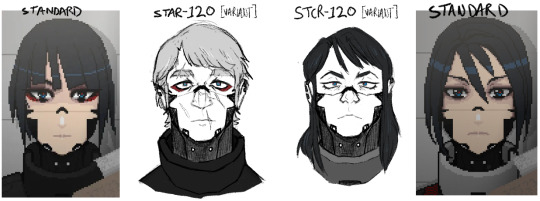
Older Starling unit paired up with new Storch unit to guard Eusan transportation vessel with a Gestalt. co-dependent androids & their human hours
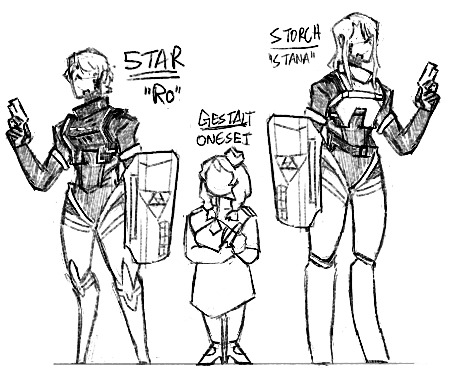
Onesei the Gestalt belongs to @brit-no
#jolly's art#signalis#signalis oc#starling#storch#lesbian#oc#survival horror#robots#android#sketch#drawing#digital art#artist on tumblr#signalis starling#signalis storch#signalis gestalt#wlw#I'm losing my fucking mind over this game please enjoy this art in the midst of my delirium
137 notes
·
View notes
Text
I did make some transformers animated aus that I might focus on in the future, some not so much and definitely won't even touch
It's nothing much, though some are pretty dark, a lot of it involves Bumblebee
So here are some of the Aus I made:
1. Tfa X Hollow Knight au
To anyone who's familiar with this game, it's nothing much
2. Held au
An au where it took place in that season 4 point where Bumblebee becomes a prime. But he got his head popped off, coincidentally Rodimus Prime lost his body (I don't know how) and they popped that bad boy (or should I say good boy?) onto BP's body and it worked and it didn't. They both struggle to co-operate.
3. Gestalt au
Same with the Held au, only Bumblebee lost his limbs, his head, and his teammates (well it's composed of bots with the 65356-9292-346 body-type). Medics popped in what's left of the team and hope Bumblebee doesn't die, and he didn't and he's suffering. His teammates become his intrusive thoughts.
4. Hollow Angel au
If you ever watch or read houseki no kuni. That's probably it... And you probably know who's Phos in this...
5. Träumen au (Signalis au)
Dear God! If you ever play or learn about this game, things are crazy in this. And Bee is Ariane... But for some reason Ironhide is Elster? I'm not sure why...
6. Tfa X Signalis X Infinity Train au
Huh?! When did I ever make this?!
7. Owl house au
Okay... Why did it finally shift to something normal? But anyone familiar, it's obvious
8. Restaurant from another world au
Aw now it's really wholesome☺️
9. High Demand au
It's just Bumblebee as Steven universe pearls the au, this au is scrapped
But there is an au that branched out from this au⬇️
10. Psychopomp/ Todesbringer au
It's basically Madoka Magica. Bee is specifically made to hunt down these "Kaputte" or broken ones from this au, though still very different from each other. Being trapped on earth, he goes kinda crazy for not hunting them down, but now they suddenly appear on earth mysteriously...
11. Dungeons and dragons au
Hell yeah!!!!!
12. Best Friend au
Inspired by kinito pet, yes, it is Bumblebee
Whelp that's all I got!
#transformers animated#tfa#transformers au#working on a transformers au#hollow knight au#signalis au#infinity train au#owl house au#restaurant from another world au#dungeons and dragons#dnd#tfa bumblebee#bumblebee#tfa rodimus prime#rodimus prime#tfa ironhide#ironhide
23 notes
·
View notes